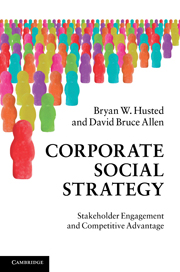Book contents
- Frontmatter
- Contents
- Figures
- Tables
- Acknowledgments
- 1 Introduction
- Part I Fundamentals
- 2 Is corporate social strategy ethical?
- 3 Theory of the firm and corporate social strategy
- 4 How do we build corporate social strategy?
- 5 Elements of successful corporate social strategy
- Part II The process of developing corporate social strategy
- Part III Implementing social strategy
- Bibliography
- Index
5 - Elements of successful corporate social strategy
Published online by Cambridge University Press: 05 June 2012
- Frontmatter
- Contents
- Figures
- Tables
- Acknowledgments
- 1 Introduction
- Part I Fundamentals
- 2 Is corporate social strategy ethical?
- 3 Theory of the firm and corporate social strategy
- 4 How do we build corporate social strategy?
- 5 Elements of successful corporate social strategy
- Part II The process of developing corporate social strategy
- Part III Implementing social strategy
- Bibliography
- Index
Summary
Corporate social projects vary greatly in terms of their scale and scope. The economic impacts of these initiatives also differ significantly. In this chapter, we ask: what is the relationship between the nature of these projects and their economic impact? In 1996, management scholars Lee Burke and Jeanne Logsdon wrote a seminal article, “How corporate social responsibility pays off,” that made a significant contribution to our understanding of how companies derive economic benefits from social projects. They developed a model that details in five dimensions how social action projects can create both social value and economic value: centrality, appropriability, proactivity, voluntarism, and visibility.
Burke and Logsdon’s model was based on their understanding of the US business context. Our research, conducted in Spain and Mexico, has found empirical support for four of these five dimensions (Husted and Allen, 2007a; 2007b; 2009). The strongest support was found for visibility and voluntarism. Some support has been found for centrality and appropriability, while no support has yet been found for proactivity in either Spain or Mexico. In this chapter, we will define and examine each of the five dimensions and their relationship to value creation from a global perspective. Let’s begin by looking more carefully at the meaning of value creation.
- Type
- Chapter
- Information
- Corporate Social StrategyStakeholder Engagement and Competitive Advantage, pp. 86 - 104Publisher: Cambridge University PressPrint publication year: 2010



